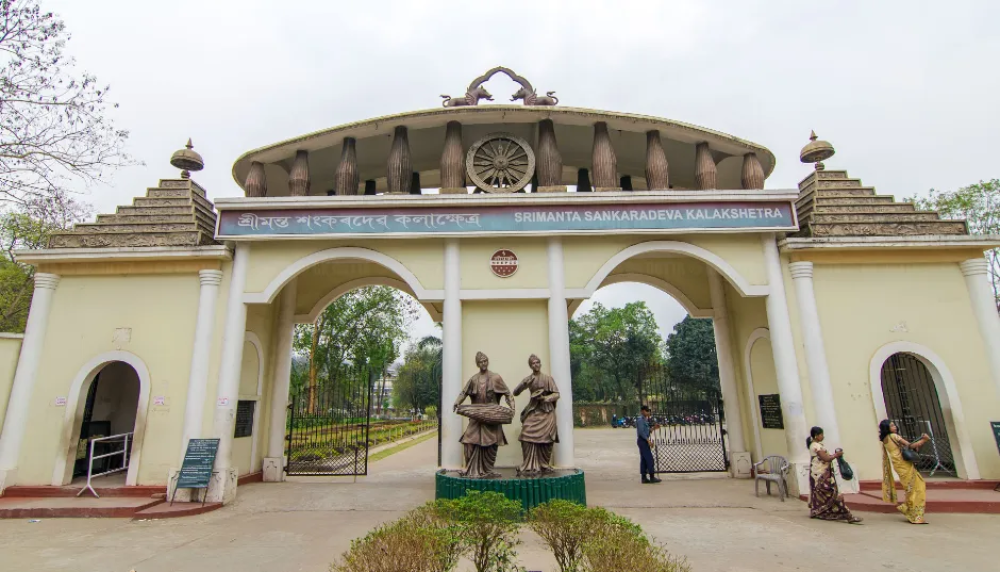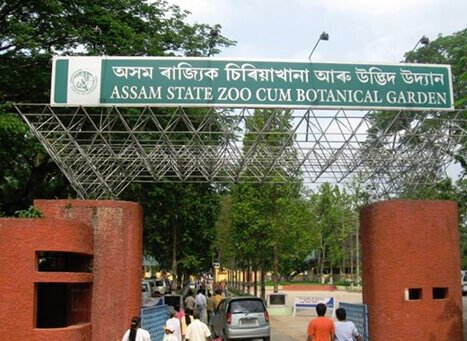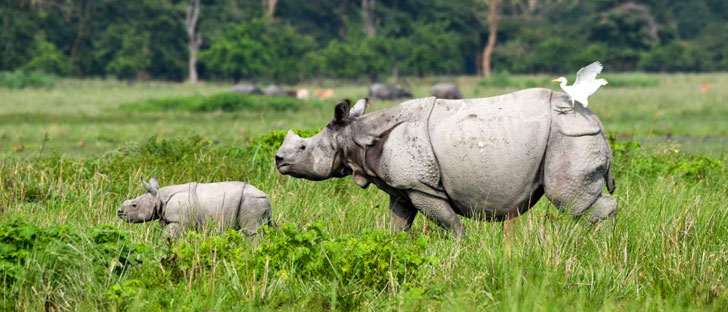
Discover Guwahati: 5 Must-Visit Places in Assam’s Cultural Capital

 :
| Updated On: 24-May-2025 @ 12:39 pm
:
| Updated On: 24-May-2025 @ 12:39 pmSHARE
1. Kamakhya Temple – A Sacred Shakti Peetha
Perched a top Nilachal Hill, the Kamakhya Temple is one of India's most revered centers of Tantric worship. Dedicated to Goddess Kamakhya, it symbolizes feminine power and fertility. The temple's unique architecture, characterized by its beehive-shaped dome, dates back to the 8th-9th century, with significant reconstructions over time. The annual Ambubachi Mela attracts thousands of devotees, celebrating the goddess's mythical menstruation cycle.
🛕 How to Reach Kamakhya Temple
Kamakhya Temple is located on Nilachal Hill, about 7–8 km from the heart of Guwahati city, Assam.
🚗 By Road:
-
You can hire a cab, auto-rickshaw, or take a local bus from anywhere in Guwahati.
-
Shared taxis and app-based cabs (Ola/Uber) are also available.
-
There is a parking area near the temple, but during peak seasons, some walking may be required.
🚉 By Train:
-
The nearest railway station is Kamakhya Junction (KYQ), which is just around 6 km from the temple.
-
Guwahati Railway Station (GHY) is also nearby (approx. 8 km).
✈️ By Air:
-
The nearest airport is Lokpriya Gopinath Bordoloi International Airport (GAU), around 20 km from the temple.
-
From the airport, taxis and ride-hailing services are easily available.
🔱 Why Kamakhya Temple is Famous
-
Shakti Peetha: Kamakhya is one of the 51 Shakti Peethas, where it is believed that the womb and vagina of Goddess Sati fell, symbolizing feminine energy and fertility.
-
Tantric Worship: It's a major center for Tantric Hinduism and attracts sadhus, pilgrims, and researchers of occult sciences.
-
Ambubachi Mela: An annual religious fair held in June, marking the menstruation period of Goddess Kamakhya. Devotees from across India visit during this time.
-
Ancient Heritage: The temple's unique Nilachal-style architecture and historic significance (dating back to the 8th-9th century) make it a spiritual and architectural marvel.
🗓️ Best Time to Visit Kamakhya Temple
-
October to March (Winter & early spring): Pleasant weather, ideal for pilgrimage and sightseeing.
-
Avoid summer (April–June) if you’re not used to high humidity and heat.
-
June (Ambubachi Mela): A spiritually powerful time to visit, but expect huge crowds and limited access due to rituals.
-
Early morning (6 AM – 9 AM) is the best time of day to avoid long queues and heat.
2. Umananda Temple – Serenity on Peacock Island
Situated on the world's smallest inhabited river island, Umananda Temple is a serene retreat dedicated to Lord Shiva. Built in 1694 by the Ahom King Gadadhar Singha, the temple stands on Bhasmacala Hill amidst the Brahmaputra River. Accessible by a short ferry ride, the island is also home to golden langurs, adding to its charm.
🛕 How to Reach Umananda Temple
Umananda Temple is located on Peacock Island (Umananda Island) in the middle of the Brahmaputra River — right in the heart of Guwahati city.
🚤 By Ferry or Boat (Only Way):
-
Reach the Umananda Ghat near Kachari Ghat or Fancy Bazaar in Guwahati.
-
From the ghat, take a government ferry or private boat service to cross the river (approx. ₹20–₹50 per ride).
-
The boat ride takes about 10–15 minutes and offers beautiful views of the Brahmaputra.
🚗 Getting to the Ghat:
-
You can take a cab, auto-rickshaw, or local transport to Kachari Ghat or Umananda Ferry Point from any part of Guwahati.
-
The ghat is about 3–4 km from Guwahati Railway Station and around 20 km from the airport.
🔱 Why Umananda Temple is Famous
-
Lord Shiva’s Shrine: The temple is dedicated to Lord Shiva and was built in 1694 by the Ahom King Gadadhar Singha.
-
Mythological Significance: It is believed that Lord Shiva meditated on this hill and that Kamadeva (the god of love) was burnt to ashes here.
-
World’s Smallest Inhabited River Island: Peacock Island is considered the smallest inhabited river island in the world.
-
Golden Langurs: Rare golden langurs, an endangered species, can sometimes be seen here.
-
Scenic Views: The island offers panoramic views of the Brahmaputra and the Guwahati cityscape.
🗓️ Best Time to Visit Umananda Temple
-
October to March (Winter): Ideal time with cool, pleasant weather.
-
Early Morning or Late Afternoon: Perfect for avoiding midday heat and enjoying peaceful surroundings.
-
Avoid Rainy Season (June–September): Boat services may be disrupted due to high water levels and strong currents.
-
Festivals: Mahashivaratri is celebrated with great devotion and draws many pilgrims.
3. Srimanta Sankardev Kalakshetra – A Cultural Odyssey
Located in Panjabari, Srimanta Sankardev Kalakshetra is a cultural complex named after the revered saint Srimanta Sankardev. Established in 1988, it showcases Assam's rich heritage through its museum, open-air theater, traditional houses, and art galleries. The complex serves as a hub for cultural activities, offering insights into the state's diverse traditions.

🛕 How to Reach Srimanta Sankardev Kalakshetra
Srimanta Sankardev Kalakshetra is located in Panjabari, a quiet and well-connected area in eastern Guwahati.
🚗 By Road:
-
Easily accessible by cab, auto-rickshaw, or city buses from any part of Guwahati.
-
From Guwahati Railway Station: approx. 11–12 km, around 30 minutes by taxi.
-
From Guwahati Airport (LGBI): approx. 30–35 km, around 45–60 minutes by car.
🚍 Local Transport:
-
Local buses and share autos regularly ply from Dispur, Ganeshguri, and Six Mile areas to Panjabari.
🎨 Why Srimanta Sankardev Kalakshetra is Famous
-
Cultural Complex: Named after Srimanta Sankardev, a 15th-century saint, reformer, and cultural icon of Assam.
-
Showcases Assamese Heritage: Includes a museum, open-air theater, heritage park, and models of traditional houses from various ethnic groups.
-
Cultural Programs: Regular hosts of cultural shows, dance performances, music festivals, and art exhibitions.
-
Educational Value: Offers a deep insight into the traditions, lifestyle, and legacy of Assam.
-
Architecture: Blends traditional Assamese design with modern aesthetics in a serene natural setting.
🗓️ Best Time to Visit Srimanta Sankardev Kalakshetra
-
October to March: The best time to visit due to cool and pleasant weather.
-
Timing: Open daily from 10:00 AM to 6:00 PM (Closed on government holidays).
-
Cultural Events: Time your visit around Bihu festivals, Rongali Bihu, or other cultural celebrations to experience vibrant local performances.
🎫 Entry Fee (as of last update):
-
Adults: ₹30–₹50
-
Children: ₹10–₹20
-
Camera charges may apply separately.
4. Assam State Zoo cum Botanical Garden – Nature's Abode
Spanning over 432 acres in the Hengrabari Reserve Forest, the Assam State Zoo cum Botanical Garden is a haven for wildlife enthusiasts. Home to over 900 animals, including the famed one-horned rhinoceros, clouded leopards, and exotic birds, the zoo also boasts a rich collection of flora, making it a perfect blend of fauna and flora.

🛣️ How to Reach Assam State Zoo
The Assam State Zoo is located within the Hengrabari Reserved Forest in Guwahati, making it easily accessible from various parts of the city.
🚗 By Road:
-
From Guwahati City Center: Approximately 6–8 km away.
-
Transport Options: Auto-rickshaws, taxis, city buses, and app-based cabs like Ola and Uber are readily available.
🚆 By Train:
-
Nearest Railway Station: Guwahati Railway Station, about 6–8 km from the zoo.
✈️ By Air:
-
Nearest Airport: Lokpriya Gopinath Bordoloi International Airport, approximately 25–28 km from the zoo.
🌟 Why It’s Famous
The Assam State Zoo cum Botanical Garden is renowned for several reasons:
-
Largest Zoo in Northeast India: Spanning over 432 acres, it houses more than 1,125 animals, birds, and reptiles representing over 115 species.
-
Diverse Wildlife: Home to species like the one-horned Indian rhinoceros, Royal Bengal tiger, clouded leopard, golden langur, hoolock gibbon, Himalayan black bear, and various exotic birds.
-
Botanical Garden: Features a rich collection of indigenous and exotic plant species, including medicinal plants and orchids, providing a serene environment for nature enthusiasts.
-
Conservation Efforts: Actively involved in the conservation of endangered species and participates in various breeding programs.
🗓️ Best Time to Visit
The ideal time to explore the Assam State Zoo is during the cooler months:
-
October to March: Pleasant weather makes it comfortable for walking and observing animals.
-
Avoid: The summer months (April to June) can be hot and humid, and the monsoon season (July to September) may have heavy rains affecting the experience.
🕒 Timings & 🎟️ Entry Fees
-
Timings:
-
Summer (April to October): 7:00 AM – 4:30 PM
-
Winter (November to March): 8:00 AM – 4:00 PM
-
Closed: Fridays
-
-
Entry Fees:
-
Adults: ₹30
-
Children (3–12 years): ₹10
-
Children (Below 3 years): Free
-
Foreign Nationals: ₹100
-
Camera Charges:
-
Still Camera: ₹100
-
Video Camera: ₹200
-
-
📝 Visitor Tips
-
Wear Comfortable Footwear: The zoo covers a large area; be prepared for walking.
-
Stay Hydrated: Carry water, especially during warmer months.
-
Follow Guidelines: Avoid feeding animals and stay within designated areas.
-
Plan Ahead: Weekends can be crowded; consider visiting on weekdays for a more peaceful experience.
5. Pobitora Wildlife Sanctuary – The Land of Rhinos
Located about 30 km from Guwahati, Pobitora Wildlife Sanctuary is renowned for its dense population of the endangered one-horned rhinoceros. Apart from rhinos, the sanctuary is a birdwatcher's paradise, hosting over 200 species of migratory and resident birds. The best time to visit is during the winter months when the sanctuary is teeming with avian activity.

🛣️ How to Reach Pobitora Wildlife Sanctuary
Situated approximately 48–56 km from Guwahati, Pobitora is easily accessible by various modes of transportation:
🚗 By Road:
-
From Guwahati: The sanctuary is about 1.5 to 2 hours' drive via NH 27 and SH 3B.
-
Transport Options: Private cabs, ride-hailing services like Ola and Uber, and car rentals are available.
-
Public Transport: State-run buses operate from Guwahati to Mayong village, near the sanctuary.
🚆 By Train:
-
Nearest Station: Jagiroad Railway Station, approximately 31 km from the sanctuary.
-
Alternative: Guwahati Railway Station, about 44.9 km away.
✈️ By Air:
-
Nearest Airport: Lokpriya Gopinath Bordoloi International Airport in Guwahati, around 65–76 km from the sanctuary.
🌟 Why Pobitora is Famous
-
High Rhino Density: Despite its small size of 38.81 sq.km, Pobitora boasts the highest density of Indian one-horned rhinoceroses globally.
-
Diverse Wildlife: Home to species like Asiatic buffalo, wild boar, leopard, wild cats, and over 200 species of migratory birds, making it a paradise for bird watchers.
-
Scenic Landscapes: The sanctuary's marshy lands, grasslands, and water bodies provide a unique habitat for various flora and fauna.
🗓️ Best Time to Visit
-
Optimal Months: November to March offers pleasant weather and is ideal for wildlife sightings and bird watching.
-
Sanctuary Timings:
-
Opening Hours: 6:00 AM to 5:00 PM.
-
Jeep Safari: Morning: 6:30 AM – 9:30 AM; Afternoon: 1:30 PM – 3:30 PM.
-
Elephant Safari: Morning slots at 6:30 AM and 7:30 AM.
-
🦏 Safari Experience
-
Jeep Safari: Offers a thrilling ride through the sanctuary, with chances to spot rhinos, wild boars, and various bird species.
-
Elephant Safari: Provides an up-close experience with wildlife, especially the one-horned rhinoceros.
-
Boat Safari: Available near the sanctuary, offering views of river dolphins and scenic landscapes.
🏨 Accommodation Options
Several eco-resorts and homestays are available near Pobitora, offering comfortable stays amidst nature:
-
Arya Eco Resort: Located close to the sanctuary entrance.
-
Maibong Eco Resort: Offers modern amenities with a rustic touch.
-
Zizina OTIS: Features traditional mud houses and tented accommodations.
-
Chanaka Eco-Camp: Provides camping experiences near the Brahmaputra River.
